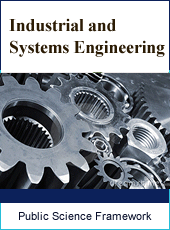Industrial and Systems Engineering
Articles Information
Industrial and Systems Engineering, Vol.1, No.1, Sep. 2016, Pub. Date: Aug. 25, 2016
Review on Research Tool Condition Monitoring and Machining Processes in Turning
Pages: 22-26 Views: 4864 Downloads: 876
[01]
Mandhadi Anusha, Department of Mechanical Engineering, IS Institute of Technology, Ongole, Andhra Pradesh, India.
[02]
Venkata Ramesh Mamilla, Department of Mechanical Engineering, IS Institute of Technology, Ongole, Andhra Pradesh, India.
[03]
G. Lakshmi Narayana Rao, Department of Mechanical Engineering, IS Institute of Technology, Ongole, Andhra Pradesh, India.
Conventional machining systems rely heavily on human operators for monitoring the process, taking the appropriate action in the event of a problem, inspecting the quality of the product, controlling the process and material handling. However, in recent years, manufacturing industry has been moving towards automated, un-manned machining to improve productivity and reliability. Thus, the implementation of an intelligent machining system, which can perform specified machining operations without detailed input from human operators in a harsh and unpredictable shop environment, has become increasingly important. This paper concerns an aspect of this general problem, namely the adaptability of a tool wear monitoring system under relatively minor changes in cutting conditions.
Review, Tool Life, Wear, Turning Process
[01]
Jae-WoongYoun, Min-Yang Yang, “A study on the relationships between static/Dynamic cutting force components and tool wear”, ASME transactions, vol.no.123, May 2001, pp. 196-205.
[02]
Yorem Koren, Tsu-RenKo, A. GalipUlsoy, KouroshDanai., “Flank wear estimation under varying cutting conditions” Transactions of ASME, vol.113, June 1991, pp. 300-307.
[03]
C. Robenstein, “An analysis of tool life based on flank face wear – part1”, ASME Journal of engineering for industry, vol. no 1, 1976, pp. 221–226.
[04]
C. Robenstein, “An analysis of tool life based on flank face wear – part 11”, ASME Journal of engineering for industry, vol. no 1, 1976, pp. 227–232.
[05]
TagrulOzel and AbhijitNadgir, “Prediction of flank wear by using back-propagation neural network modeling when cutting hardened H-13 steel with chamfered and honed CBN tools”, International Journal of Machine Tools and Manufacturing 42 (5) (1994) 287–297.
[06]
A. Nadgir, T. O¨ zel, Neural network modeling of flank wear for tool condition monitoring in orthogonal cutting of hardened steels. In: Proceedings of 4th International Conference on Engineering Design and Automation, July 30–August 2, Orlando, Florida,USA, 2000.
[07]
R. G. Khanchustambham, “A neural network approach to on-line monitoring of machining processes”, System research center, University of MARYLAND, 1992.
[08]
R. G. Khanchustambham, G. M. Zhang, A neural networkapproach to on-line monitoring of turning process, in: International Joint Conference on Neural Networks, Baltimore, Maryland, 1992, pp. 889–894.
[09]
HMT, “Production Technology” 2000.
[10]
A, Ghosh and A. K. Mallik., “Manufacturing Technology” East-west press, NewDelhi, 1998.
[11]
Sen and Bhattacharya., “Metal cutting mechanics”.
[12]
Fryderyk E. Gorczyca, P. E., C. Mfg. E “Application of metal cutting theory”, Industrial press, Newyork, 1987.
[13]
Geoffrey Boothroyd and Winston A. Knight, “Fundamentals of machining and machine tools”, Marcel Decker pub,US 1989.
[14]
Laurence Fausett, “Fundamentals of neural networks” Prentice Hall, Englewood Cliffs, 1997.
[15]
Gold Berg, “Genetic Algorithms” 1993.
[16]
Ranjit Roy, “A primer on Taguchi method”1997.
[17]
Trent, E. M., Wright, Paul K. Metal Cutting. Boston: Butterworth-Heinemann, 2000.
[18]
P. C. Sharma, “Production Engineering”, SCHAND & Company, 2000.
[19]
S. K. HajraChoudhury, S. K. Bose, A. K. HajraChoudhury, “Elements of Workshop Technology- Vol 11”, Media promoters & Publishers Pvt Ltd, 1994.

ISSN Print: Pending
ISSN Online: Pending
Current Issue:
Vol. 2, Issue 4, July Submit a Manuscript Join Editorial Board Join Reviewer Team
ISSN Online: Pending
Current Issue:
Vol. 2, Issue 4, July Submit a Manuscript Join Editorial Board Join Reviewer Team
| About This Journal |
| All Issues |
| Open Access |
| Indexing |
| Payment Information |
| Author Guidelines |
| Review Process |
| Publication Ethics |
| Editorial Board |
| Peer Reviewers |


